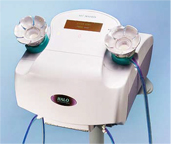
Colleyville - 817-251-6533
Ft. Worth - 817-926-2511





Breast Health Protection
Breast Thermography
Thermography, also referred to as Digital Infrared Thermal Imaging, is a non-contact, non-invasive, radiation-free procedure used to visualize the body’s physiologic response. There are no risks and no side effects. It is an adjunctive exam that can provide a more comprehensive picture for ongoing breast health monitoring. FEM Centre recommends that breast thermograms be a part of a woman’s annual breast health regimen.
During thermography, thermal patterns are displayed on the skin and detected by a specialized camera’s infrared sensor. Interpreted as temperature data, it is transmitted to the computer, where all images are stored. All information that is gathered is correlated to the patient’s main area of concern, complaint, or symptoms. By detecting thermal asymmetry, thermal imaging offers the patient and medical practitioner an added dimension to the breasts’ diagnostic picture, detecting neurological and vascular information not available on x-ray*.
- Thermography is the test of choice for monitoring breast health and changes associated with breast disease. It helps:
- Detect thermal indicators as they relate to infection, inflammation, or fibrocystic disease.
- Determine thermal indications of angiogenic significance which requires further evaluation
Thermography can be done on women of any age as a screening test for early detection of changes in breast health. It is ideal for differentiation of fibrocystic disease from possible active tumors on women under 40 who have dense breast tissue. Thermal imaging may help detect the increased metabolic heat associated with the greater vascularity of suspicious growths,and can sense this "thermal signal" several years before a mass can be detected on by x-ray or mammography.
FEM Centre strives to provide the best in medical care. Breast thermography can help both us and you make informed decisions concerning the need for further evaluation of your breast health. A monthly breast self-exam – accompanied by annual physician exams, HALO Breast Pap Tests, thermograms, and mammograms – may help increase the effectiveness of early breast tissue abnormality detection to better than 95%.
HALO™ Breast Pap Test
FEM Centre is the first clinic in the North Texas area to offer breast health assessment at cellular level with the HALO Breast Pap Test — an FDA-approved, quick, safe, noninvasive method for obtaining breast fluid for laboratory examination.

HALO combines warmth, massage, and suction to collect nipple aspirate fluid (NAF, found in the milk ducts, where 95% of all breast cancers originate). The collected fluid is sent to a laboratory for examination to determine and/or differentiate normal versus pre-malignant versus malignant cells. A woman with atypical cytology has a 4 to 5 times greater risk of developing breast cancer than a woman who does not produce fluid. This risk is even greater when combined with a family history of breast cancer. The screening and collection process takes only five minutes.
Regular assessment with HALO allows us to monitor the health of your breast and provides us the ability to react to cellular changes as early as possible.
Who should take advantage of the HALO Breast Pap Test?
FEM Centre recommends that this test be performed annually on women ages 25-59 years of age. Why so young? HALO can be effective in younger women who are not yet having mammograms. Additionally, younger women with breast cancer can have worse outcomes and usually a more advanced stage of disease than older women, and a breast cancer diagnosis within two years of childbirth has a nearly 50% mortality rate.
Does the HALO Breast Pap Test replace mammograms?
No. The HALO is a complement to mammograms – a tool to help assess your future risk for breast cancer at a cellular level. A mammogram is a screening tool that can detect a possibly cancerous lesion, but only after the cells have multiplied to the point where a mass can be detected on film.
* Thermal imaging is not designed to replace the mammogram, but, when used in conjunction with a mammogram, is a powerful screening tool to help identify physiologic changes in the breasts, allowing for early intervention.

